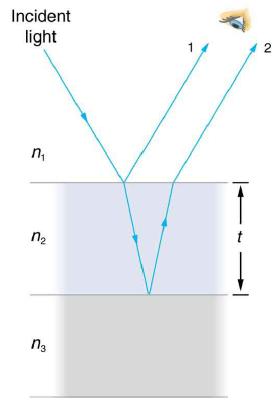A non-reflective coating like the one described in Example 27.6 works ideally for a single wavelength and
Question:
A non-reflective coating like the one described in Example 27.6 works ideally for a single wavelength and for perpendicular incidence. What happens for other wavelengths and other incident directions? Be specific.
Data from Example 27.6
Sophisticated cameras use a series of several lenses. Light can reflect from the surfaces of these various lenses and degrade image clarity. To limit these reflections, lenses are coated with a thin layer of magnesium fluoride that causes destructive thin film interference. What is the thinnest this film can be, if its index of refraction is 1.38 and it is designed to limit the reflection of 550-nm light, normally the most intense visible wavelength? The index of refraction of glass is 1.52.
Strategy
Refer to Figure 27.33 and use n1 = 1.00 for air, n2 = 1.38, and n3 = 1.52. Both ray 1 and ray 2 will have a λ/2 shift upon reflection. Thus, to obtain destructive interference, ray 2 will need to travel a half wavelength farther than ray 1. For rays incident perpendicularly, the path length difference is 2t.
Data from figure 27.33

Step by Step Answer:






